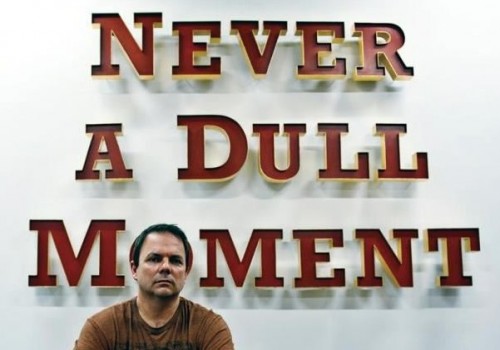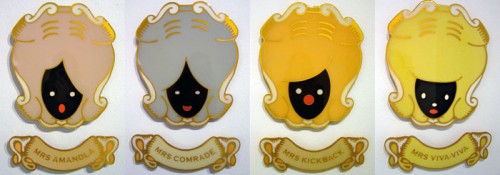Hail to the Thief. Brett Murray. Goodman Gallery, Johannesburg.
KATE ELLIS-COLE

While the artist, Brett Murray, was off having his hide tanned for being an alleged racist, his exhibition “Hail to the Thief” went into its last week on display in Johannesburg’s Goodman Gallery.
One might think that, sans Jacob Zuma’s painted penis on public presentation, the exhibition would lose its draw, but the contrary is true. Walking into the modern and minimalist gallery, visitors are greeted with a small taste of the satire you can expect inside, with parody street signs that read: “Beware of falling stocks” and “The buck stops here” standing proudly before the entrance.
“Satire is critical entertainment”, says Murray. Through the gallery’s doors, the satire is so thick, one has to wade through it. Parodies of recognisable brands, previous campaigns of a political and presidential nature,

both in the Republic and abroad, adorn the chic white walls. A Johnny Walker “Forward Comrade!” rip-off is the first of many clever twists on old favourites that hints at Murray’s real gripe: not at all a quibble of a racial nature, but rather a much needed, punchy, reminder that promises that were made should not be broken.
Indeed, this sentiment is anchored by the huge display on the central wall of the gallery: “Promises, Promises, Promises”, it laments. The piece is situated on the wall that seems to link together the three main strands of the exhibition. The one is a direct call to the ANC to remember who they were and what the struggle made of them; the second, a wounded cry for South Africa over our current less-than-desirable state; and the third a mocking glance at international political movements that have gotten it wrong.
What Murray suggests is that the South African government should not be modeled on regimes that have proved jeopardous to their people. His real message is that we should remember the ideal we all (or some of us, at least) passionately envisaged in the Freedom Charter. Freedom in our time!
It is undeniable that Murray is speaking up, and in a big way. He lambasts and exposes without shame or restraint. The pieces aim for the jugular, and spectators are loudly called to action themselves through the bright, symbolic colours, the bold fonts and clever slogans, the intricate designs and admirable artistry.
At no point, however, is the exhibition a racial slur. In fact, the overriding sense is that what Murray wants is what we all want – for the ANC to follow through and uplift the entire nation, as it swore to do in even more bitter times. He twists old protest posters into wall hangings that read:

“All shall NOT be equal before the law”, “There shall NOT be security and houses for all”, and “There shall NOT be peace and friendship”. Not altogether untrue.
The Victor Ivanov style evident in the now infamous “The Spear” carries through to other pieces that warn of a fall into an old-style communism. Many of the works are written in a typeface that resembles the figures of Russian script, and symbols of the communist era make up a strong refrain in the exhibition.
Communist Russia is not the only political regime called into question, however; even the exhibition’s title, “Hail to the Thief”, smacks of the American “Hail to the Chief” – a presidential tribute song. The American theme also seems to rear its head in certain pieces such as “The Untouchables”,

suggesting those much imagined and admired early American super-heroes.
Weapons that more properly belong with gangs than with parliament are portrayed in guises such as wall hangings and wreaths. An especially unnerving piece called “Persuasion” presents, simply, a pair of gold-plated knuckle-dusters with the word “Viva” etched across the top of each.
It is sometimes said that South Africans have a unique ability to laugh at themselves. This characteristic is clear in many of the pieces, which are actually very amusing. The piece called “The Wives” is a collection of four caricatured faces,

one called ‘Mrs Amandla’, the next “Mrs Comrade”, a third “Mrs Kick-Back” and finally, “Mrs Viva-Viva”. Another piece imitates the “Get out of jail free”-card from the game Monopoly, but uses the ANC as the free ticket. Clever, silly, and loaded with connotations that are relevant to even the most disinterested viewer, the pieces ensure that you don’t stop contemplating their meaning, even though you giggle.
The acuity expressed in the pieces leaves a poignant though unsettling sense in your mind as you scan the aesthetically pleasing but shocking pieces on display. The wall where J.Z. and his winky used to hang has been left bare, not quite conspicuously so, but all the same, the lack of the Stalinesque portrait does not detract from Murray’s message. In fact, by overreacting to a single piece that was isolated from the context in which it fit so seamlessly, the message has been largely garbled. As Murray says: “It is a work of protest or resistance art, and it is a satirical piece.”

 SLiPStellenbosch Literary Project
SLiPStellenbosch Literary Project
A local version of High-Art Lite, as Mary Corrigall pointed out in the Sunday Independent yesterday.